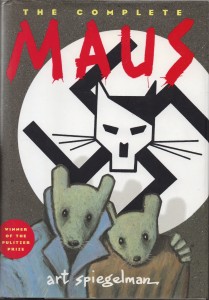Maus
by Olivia-Beate Franzini
It only dawned on me, as I opened my backpack and saw my tattered copy of Art Spiegelman’s Maus, that it would be immensely fitting that I blog on the text I have become so familiar with over the last couple of months. As a 7th grade reading and writing teacher, I have chosen to add Maus this year to my curriculum this year.
Maus is a Holocaust memoir written by Art Spiegelman in the form of a graphic novel. Being a graphic novel, it has a great a
 ppeal to my students. It has also fostered their curiosity in learning that a memoir can be read in the form of graphic novel. The lines that separate genre have become blurred to them, and they are left very puzzled and asking very poignant questions (I love it).
ppeal to my students. It has also fostered their curiosity in learning that a memoir can be read in the form of graphic novel. The lines that separate genre have become blurred to them, and they are left very puzzled and asking very poignant questions (I love it).
Maus serves a vehicle for Spiegelman to unfold his father’s story of being a Polish POW who was later sent to Auschwitz with the rest of Spiegelman’s family. At the same time there is a second storyline, as Spiegelman tells in own story, pictured throughout the chapters interviewing his father. Spiegelman broaches the topic of the mental breakdown he suffered as a young adult, derived from the issues associated with growing up a child of Holocaust survivors. The same depression inherited from his mother, that causes her to take her own life.
What makes Maus even more engaging is Spiegelman’s use of anthropomorphism. It has been speculated by some critics that Spiegelman’s own inability to comprehend the events was the inspiration for this method. Being natural sworn enemies, Spiegelman depicts the Nazi’s as cats and the Jews as mice (Maus being mouse in German).
It is an engaging page-turner that displays the horrors of the Holocaust through a new lens. At a later time I will follow up my post with my students own critqiues on the novel as they dive in to their studies.


